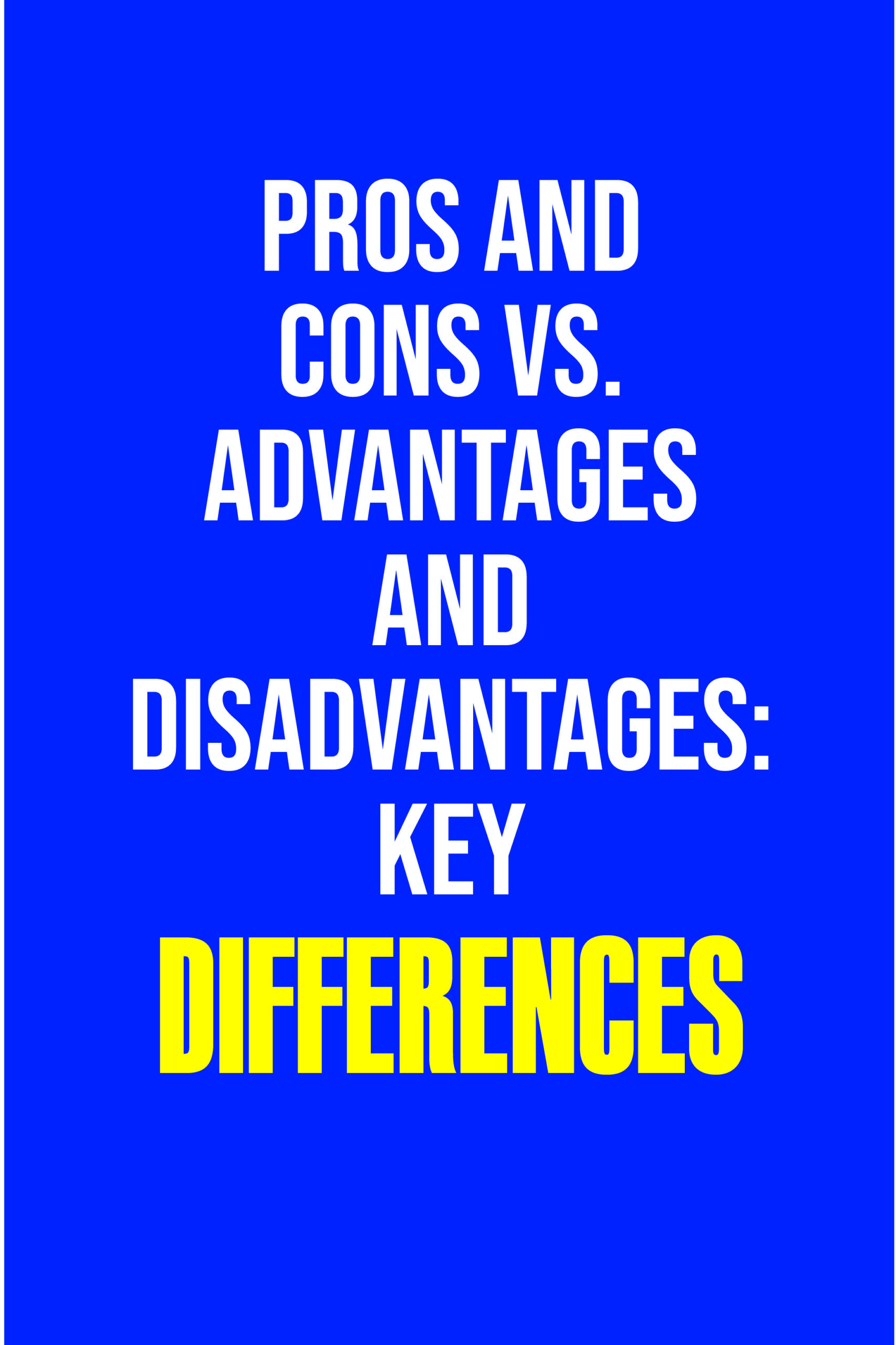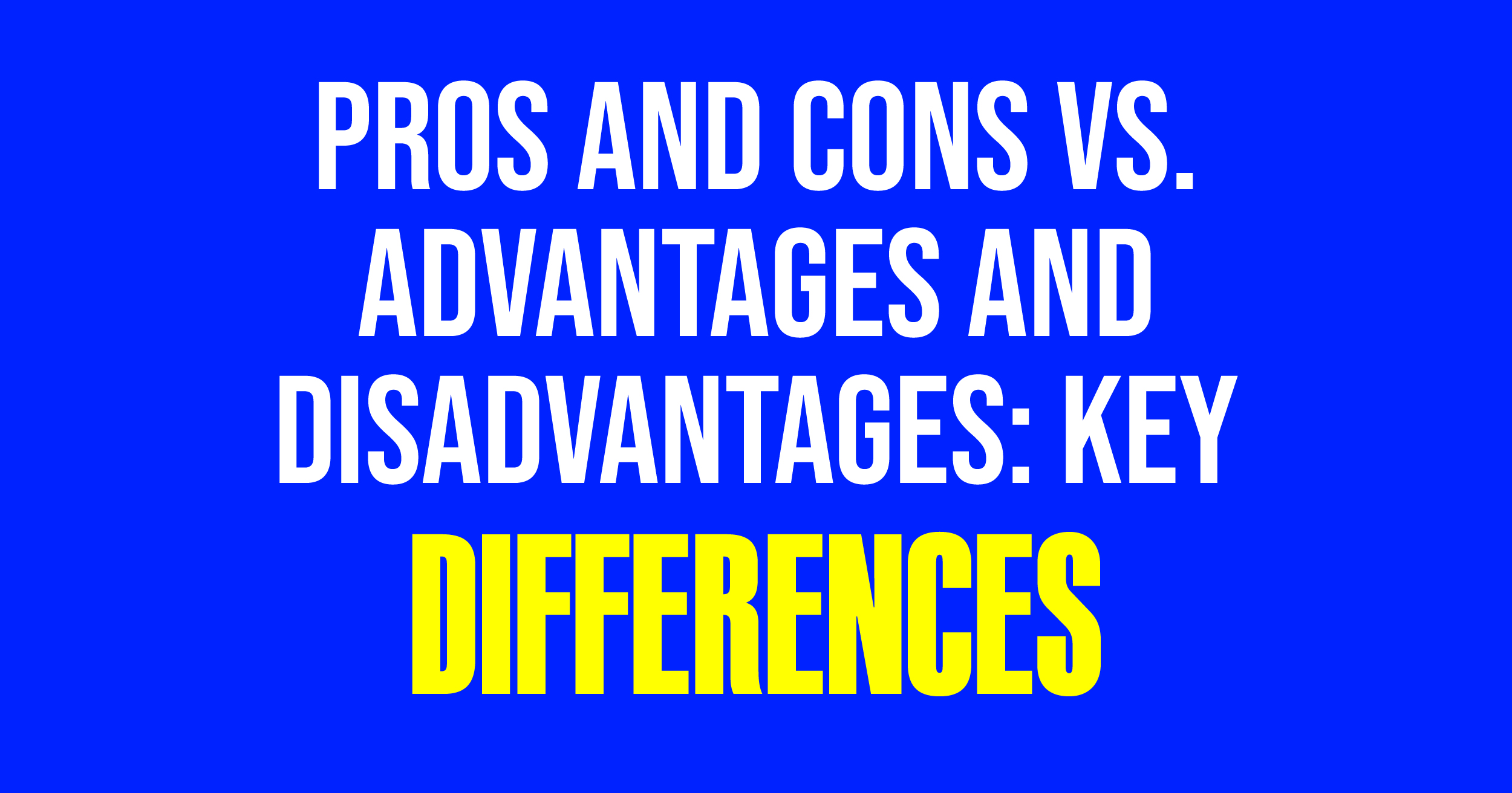Pros and cons, and advantages and disadvantages, are terms often used interchangeably to weigh options. Both phrases outline the positives and negatives of a decision, but their context may vary.
Delving into the realm of decision-making, understanding the subtle differences between “pros and cons” and “advantages and disadvantages” can be crucial. These phrases guide us through the complexities of choices, be it in our personal lives, business decisions, or academic pursuits.
They serve as a balanced scale, presenting both sides of a coin, helping us to evaluate options critically. This analytical approach not only simplifies decision-making but also enhances our ability to predict outcomes. Whether we’re drafting a business proposal, making a career choice, or simply deciding on our next vacation spot, recognizing the positive and negative aspects under each category encourages a thorough examination. This method fosters an environment of informed decision-making, ensuring that we consider all possible outcomes before taking a step forward.

Credit: rebelsguidetopm.com
Introduction To Terminology
Introduction to Terminology dives into the world of words. We explore how different terms impact understanding and communication. Today, we focus on “Pros and Cons” versus “Advantages and Disadvantages”. Let’s unravel these terms.
Setting The Context
Words shape our thoughts and decisions. “Pros and Cons” and “Advantages and Disadvantages” are terms we often use. They help us weigh options. Yet, they carry subtle differences.
Importance Of Language Precision
- Clarity: Precise language leads to clear thinking.
- Decision Making: It aids in making informed choices.
- Communication: Accurate terms improve understanding.
Choosing the right words is key. It ensures our message is understood. Let’s explore these terms further to make better decisions.

Credit: www.researchgate.net
Historical Evolution Of The Terms
The phrases ‘pros and cons’ and ‘advantages and disadvantages’ are deeply rooted in history. Each has its own origin story, tracing back through the centuries. These terms have evolved from classical roots to become a common part of our decision-making vocabulary today. Let’s dive into the historical journey of these phrases.
Etymology Of ‘pros And Cons’
The term ‘pros and cons’ is an abbreviation. It stems from the Latin phrase ‘pro et contra’. ‘Pro’ means ‘for’, and ‘contra’ means ‘against’. These Latin terms were used in medieval times. Scholars debated using arguments ‘for and against’ a point. This practice shaped modern discussion techniques. The phrase got shortened over time. ‘Pros and cons’ is now widely used in English.
Origins Of ‘advantages And Disadvantages’
The longer phrase ‘advantages and disadvantages’ has its own story. ‘Advantage’ comes from the Old French ‘avantage’. This term means ‘to come before’ or ‘to benefit’. ‘Disadvantage’ pairs the Latin prefix ‘dis-‘ with ‘advantage’. It implies a reversal of a positive condition. Together, they weigh the positive against the negative. This phrase entered English around the 14th century. It is still a staple in evaluative discussions.
Pros And Cons Explored
Understanding the positives and negatives is crucial. It leads to informed choices.
Common Usage Scenarios
People weigh options daily. It’s a part of decision-making.
- Buying a product involves pros and cons.
- Business decisions require careful analysis.
- Personal choices benefit from this practice.
Implications In Decision Making
Pros and cons affect outcomes. They shape our decisions.
| Pros | Cons |
|---|---|
| Lead to positive results | May reveal potential issues |
| Encourage progress | Can cause hesitation |
Advantages And Disadvantages Unpacked
Choosing the right terms can shape our understanding.
Advantages and disadvantages offer clear insight.
Preferred Contexts For Use
Words matter in different scenarios.
- Pros and Cons are for everyday talk.
- Advantages and Disadvantages fit formal writing.
Connotations In Academic And Professional Settings
Professional fields prefer specific language.
Advantages and Disadvantages are academic and professional.
They bring a level of seriousness to the text.
Comparative Analysis
Choosing the right words is key in communication.
It shapes understanding and drives decisions.
Nuance In Meaning
Different terms can convey similar ideas.
Yet, they often carry subtle distinctions.
Pros and cons suggest a casual, balanced review.
Advantages and disadvantages sound more formal and comprehensive.
Impact On Perception And Bias
Word choice can influence reader’s thoughts.
It may even sway opinions before facts are presented.
Using “pros and cons” might imply a more personal take.
“Advantages and disadvantages” can seem more objective and analytical.
Psychological Perspective
Psychological Perspective explores how words shape our thoughts. Words like “Pros and Cons” and “Advantages and Disadvantages” might seem similar. Yet, they influence our brain differently. This section dives into their psychological impacts.
Cognitive Processing Of Each Term
Our brain handles words in unique ways. “Pros and Cons” suggests balance. It feels casual. “Advantages and Disadvantages” seems formal. It hints at thorough analysis. This difference matters.
- Pros and Cons: Quick decisions, less stress.
- Advantages and Disadvantages: Careful choices, more details.
Influence On Behavioral Outcomes
Words guide our actions. “Pros and Cons” might lead us to decide fast. We weigh options simply. “Advantages and Disadvantages” encourage deep thinking. We consider more factors.
| Term | Decision Speed | Depth of Thought |
|---|---|---|
| Pros and Cons | Fast | Basic |
| Advantages and Disadvantages | Slow | Detailed |
Linguistic Considerations
Exploring the words we choose reveals much about communication. ‘Pros and cons’ versus ‘advantages and disadvantages’ are common phrases. Both convey similar meanings but differ in use. Let’s dive into the linguistic aspects of these phrases.
Syntax And Diction
Syntax shapes our understanding of language. ‘Pros and cons’ often implies a quick, informal assessment. ‘Advantages and disadvantages’ suggests a more formal, thorough analysis. Diction, or word choice, affects tone and clarity. Short, familiar words like ‘pros’ and ‘cons’ are easily grasped. Longer words like ‘advantages’ and ‘disadvantages’ may carry more weight and detail.
Translation And Cultural Variations
Translation adds complexity. ‘Pros and cons’ might not translate directly into other languages. This can confuse non-English speakers. Different cultures have unique ways of evaluating options. Recognizing these variations is crucial for clear communication.

Credit: helpfulprofessor.com
Practical Implications In Various Fields
Exploring the practical implications in various fields reveals how terms like ‘pros and cons’ and ‘advantages and disadvantages’ drive decision-making. Let’s delve into specific domains and how these considerations impact them.
Business And Economics
In business, ‘pros and cons’ guide strategic choices. ‘Advantages and disadvantages’ influence economic policies. Here’s how:
- Market Analysis: Companies weigh benefits and drawbacks before entering markets.
- Risk Assessment: Firms consider potential gains and losses to mitigate risks.
- Policy Development: Economists evaluate positive and negative impacts of regulations.
Science And Technology
Scientific breakthroughs and tech advancements come with their own set of pros and cons. Look at these examples:
| Aspect | Advantages | Disadvantages |
|---|---|---|
| Innovation | Improves lives | May have unforeseen consequences |
| Automation | Boosts efficiency | Potentially reduces jobs |
Ethics And Philosophy
Ethical dilemmas and philosophical debates rely heavily on weighing different sides. Consider these points:
- Debates on morality often reflect on the good and bad outcomes of actions.
- Philosophical discussions use advantages and disadvantages to form arguments.
- Ethical theories are tested against real-world scenarios to assess their validity.
Frequently Asked Questions
Does Pros Mean Advantages?
Yes, “pros” typically refers to advantages or positive aspects of a situation or decision.
What Is Pros And Cons Short For?
“Pros and cons” is short for “pros and cons,” which means the advantages and disadvantages of a particular decision or course of action.

Does Pros And Cons Mean Advantages And Disadvantages?
Yes, “pros and cons” indeed means advantages and disadvantages. This phrase is commonly used to weigh the positives and negatives of a situation.
What Do Cons Stand For?
“Cons” stands for disadvantages or negative aspects. It’s used to highlight the drawbacks or less favorable points in discussions or comparisons.
Conclusion
Navigating the terrain of decision-making can be complex. ‘Pros and cons’ and ‘advantages and disadvantages’ serve as guides, each with its own merits. Our discussion aimed to demystify these terms, aiding your choice process. Embrace them as tools, and you’ll make informed decisions with clarity and confidence.
Remember, the right framework can illuminate the best path forward.

